NCERT Exemplar Class 6 Science Chapter 1 Food: Where Does It Come From? are part of NCERT Exemplar Class 6 Science. Here we have given NCERT Exemplar Class 6 Science Solutions Chapter 1 Food: Where Does It Come From?
NCERT Exemplar Class 6 Science Chapter 1 Food: Where Does It Come From?
Multiple Choice Questions
Question 1.
Given below are names of some animals.
(i) Goat
(ii) Human beings
(iii) Cockroach
(iv) Eagle
Which of the above animals form a pair of omnivores?
(a) (i) and (ii)
(b) (ii) and (iii)
(c) (iii) and (iv)
(d) (ii) and (iv)
Solution:
(b) : Goats eat only plants and plant products so they are herbivores. Eagles eat flesh of other animals so, they are carnivores. Humans and cockroaches eat both animals and plants so, they are omnivores.
Question 2.
Honeybee makes honey from
(a) pollen
b) petals
(c) nectar
(d) bud.
Solution:
(c) : Honeybees collect nectar from flowers and take it to their beehive. There they convert it into honey and store it as food. We get honey from beehives.
Question 3.
Below are names of some animals.
(i) Cow
(ii) Sheep
(iii) Horse
(iv) Ox
Which of the above are sources of milk for human beings?
(a) (i) and (iii)
(b) (i) and (ii)
(c) (ii) and (iii)
(d) (iii) and (iv)
Solution:
(b) : Cow and sheep are dairy animals i.e., they are kept for obtaining milk. They are also called milch animals.
Ox and horse are draught animals i.e., they arc used in agriculture and for transport.
Question 4.
Given below is a list of edible plants.
(i) Banana
(ii) Pumpkin
(iii) Lady’s finger
(iv) Brinjal
Which pair of plants have two or more edible parts?
(a) (i) and (ii)
(b) (ii) and (iii)
(c) (iii) and (iv)
(d) (i) and (iv)
Solution:
(a) : In banana plants, stem, fruit and flower are edible and in pumpkin plants, flower and fruit are edible. In lady’s finger and brinjal plants, only the fruit is edible.
Question 5.
The part of a banana plant not used as food is
(a) flower
(b) fruit
(c) stem
(d) root.
Solution:
(d): Refer to answer 4.
Question 6.
Read each set of terms and identify the odd set.
(a) Cow, milk, butter
(b) Hen, meat, egg
(c) Goat, milk, meat
(d) Plant, vegetable, butter milk
Solution:
(d): Vegetables are plant parts whereas butter milk is an animal product.
Short Answer Type Questions
Question 7.
Read the clues and fill up the blanks given below each of them.
(a) Honeybees suck from flower.
N_ _T_R
(b) Animals which eat other animals.
_A _N_V_R_S
(c) Animals which eat only plants and plant products.
HE_B_ _ _ _ E_
(d) Animals which eat both plants and animals.
_MN I_O_ _ _
Solution:
(a) NECTAR
(b) CARNIVORES
(c) HERBIVORES
(d) OMNIVORES
Question 8.
Why do boiled seeds fail to sprout?
Solution:
Boiling kills the seed so, boiled seeds fail to sprout.
Question 9.
Where do bees store honey?
Solution:
Bees store honey in beehives.
Question 10.
Name two ingredients in our food that are not obtained from plants or animals. Mention one source for each ingredient.
Solution:
Two ingredients in our food that are not obtained from plants or animals are salt and water. Salt is obtained from sea water and from rock. Water is obtained from river, well, tube well, rain etc.
Question 11.
Given below are jumbled words which are names of parts of a plant. Rearrange them to get the correct words.
(a) LILCHI
(b) ITRUF
(c) SEANBOYA
(d) GURSA
(e) ROUNDGUNT
Solution:
(a) CHILLI
(b) FRUIT
(c) SOYABEAN
(d) SUGAR
(e) GROUNDNUT
Short Answer Type Questions
Question 12.
Identify the animals in the grid given below as Fig. 1.1 and categorise them into herbivore, carnivore and omnivore.
Solution:
| T | A | c | O | W | 0 | L | F |
| T | A | R | W | X | G | 0 | R |
| N | N | 0 | L | 1 | 0 | N | 0 |
| E | T | W | Q | L | A | N | G |
| H | U | M | A | N | T | W | 0 |
Fig 1.1
Solution:
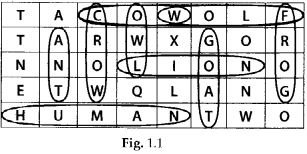
Herbivore – Cow, Goat, Hen
Carnivore – Wolf, Lion, Frog
Omnivore – Cat, Rat, Crow, Human, Ant, Owl
Question 13.
Why should we avoid wastage of food?
Solution:
We should avoid wastage of food because :
(i) Enough food is not available for all of us
(ii) Food is very costly and poor people cannot afford to buy even the minimum required amount of food.
Question 14.
Why do organisms need food? Write two reasons.
Solution:
Organisms need food because
(i) Food gives energy to do work.
(ii) Food helps the body to grow and to repair damaged parts.
(iii) Food helps to protect the body against diseases.
Question 15.
Match the organisms given in column I with their part product in column II that is used by human beings as food.
| Column 1 | Column II | ||
| (a) | Mustard plant | (i) | meat |
| (b) | Goat | (ii) | fruits and vegetable |
| (c) | Hen | (iii) | seed |
| (d) | Smoke | (iv) | direction of airflow |
| (e) | Wind | (v) | prevent dust particles |
Solution:
The above given question is incorrect.
Question 16.
Label and colour the different parts of the plant given below in Fig. 1.2.
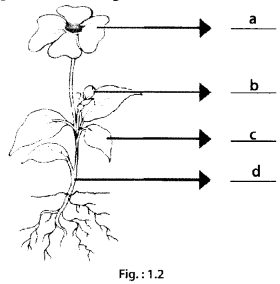
Solution:
(a) Flower
(b) Floral bud
(c) Leaf
(d) Stem
Long Answer Type Questions
Question 17.
Read the names of animals written in the inner ring of Fig. 1.3. Within the second ring write the types of food they eat and the category to which they belong (based on the eating habit) in the outermost ring. One example has been worked out for you. Use red, green and blue colours for writing.
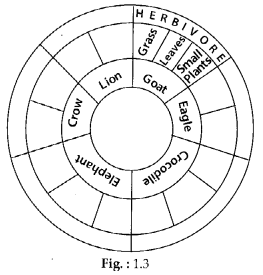
Solution:
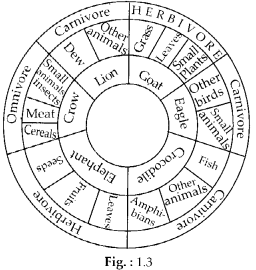
Question 18.
Connect the animal with the food it eats by an arrow using different colours in Fig. 1.4. One is done for you.
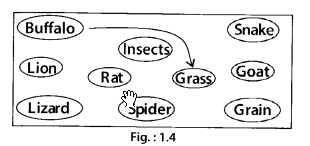
Solution:
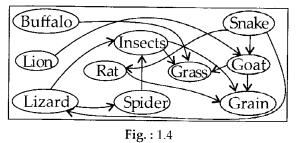
Buffalo – Grass
Lion – Goat
Lizard – Insects, Spider
Rat – Grain
Insect – Grain, Grass
Spider – Insects
Snake – Rat, Lizard, Goat
Goat – Grass, Grain
Question 19.
List two of your favourite food items and mention their ingredients.
Solutions:
| Food items | Ingredients | |
| 1. | Kidney beans (Rajmanh) | Kidney beans, onions, tomatoes, oil, water, salt, spices |
| 2. | Kheer | Rice, milk, water, Cardamom, sugar |
NCERT Exemplar Class 6 Science Solutions
- Chapter 1 Food: Where Does It Come From?
- Chapter 2 Components of Food
- Chapter 3 Fibre to Fabric
- Chapter 4 Sorting Materials into Groups
- Chapter 5 Separation of Substances
- Chapter 6 Changes around Us
- Chapter 7 Getting to Know Plants
- Chapter 8 Body Movements
- Chapter 9 The Living Organisms and Their Surroundings
- Chapter 10 Motion and Measurement of Distances
- Chapter 11 Light, Shadows and Reflections
- Chapter 12 Electricity and Circuits
- Chapter 13 Fun with Magnets
- Chapter 14 Water
- Chapter 15 Air Around Us
- Chapter 16 Garbage In, Garbage Out
We hope the NCERT Exemplar Class 6 Science Chapter 1 Food: Where Does It Come From? will help you. If you have any query regarding NCERT Exemplar Class 6 Science Solutions Chapter 1 Food: Where Does It Come From? , drop a comment below and we will get back to you at the earliest.